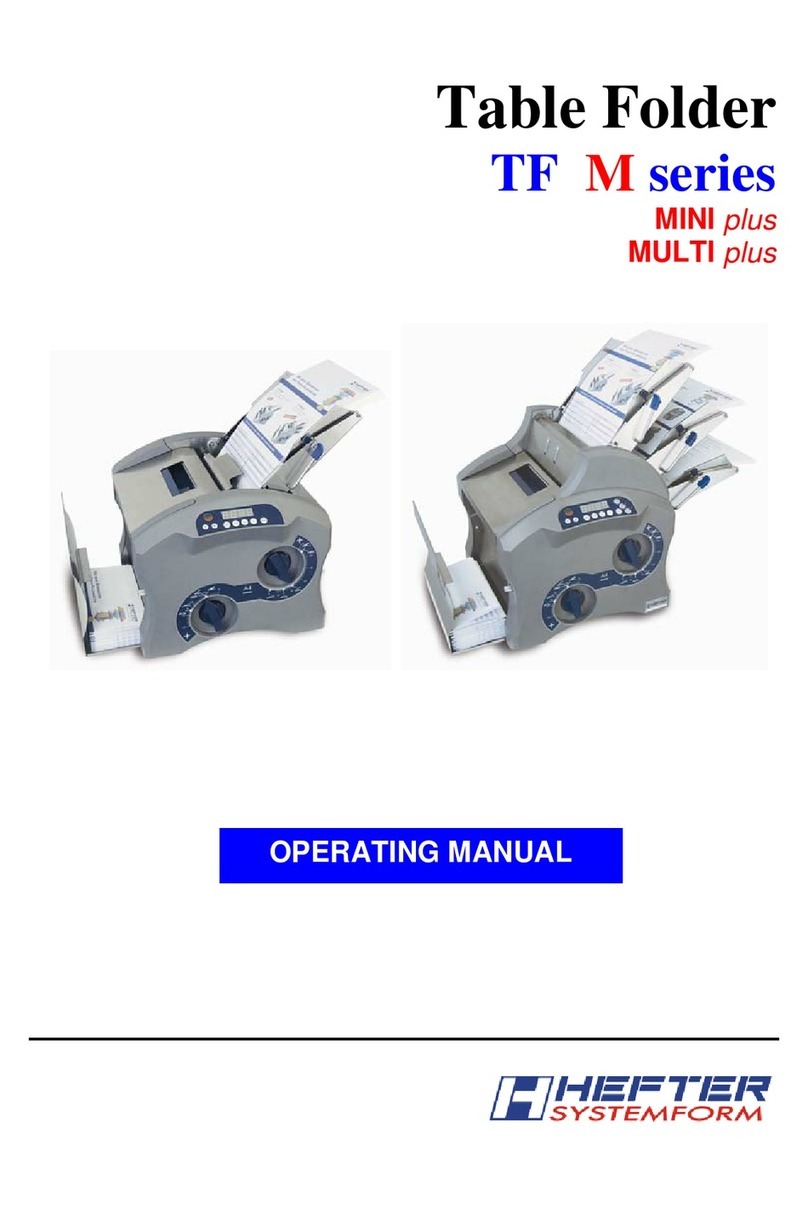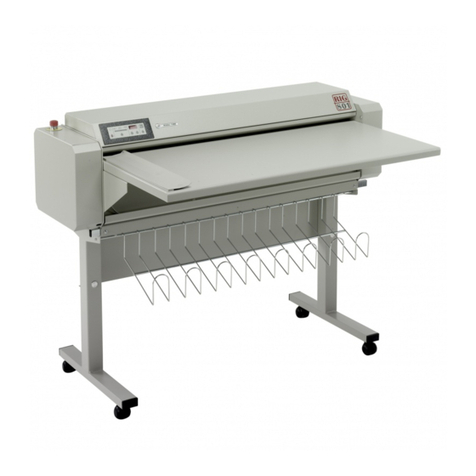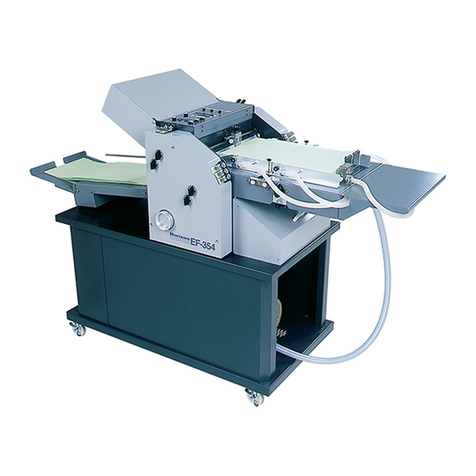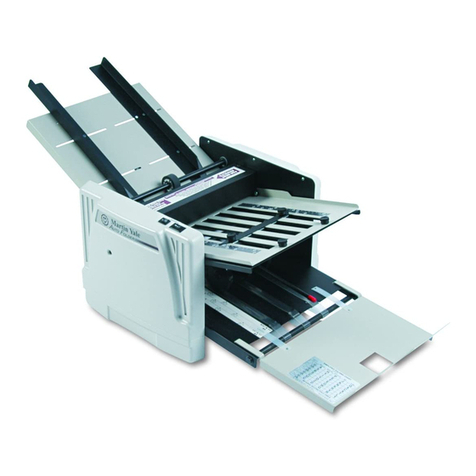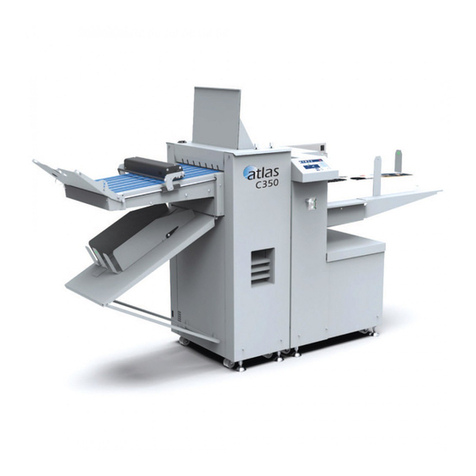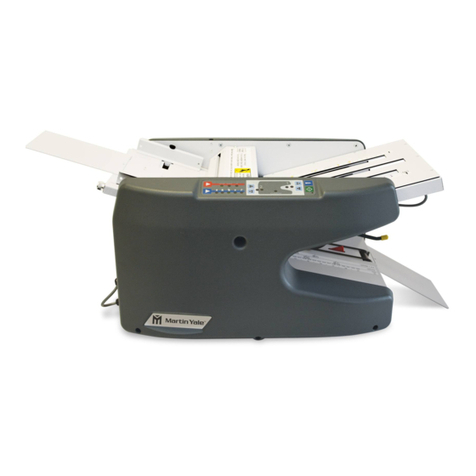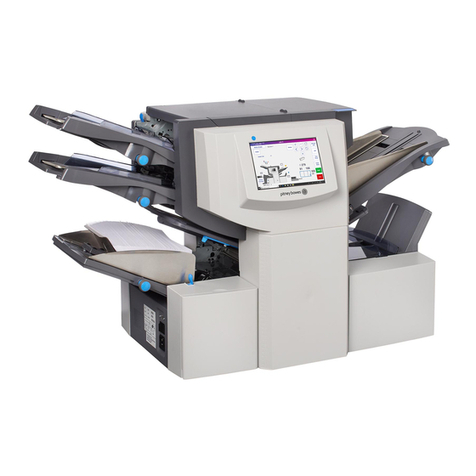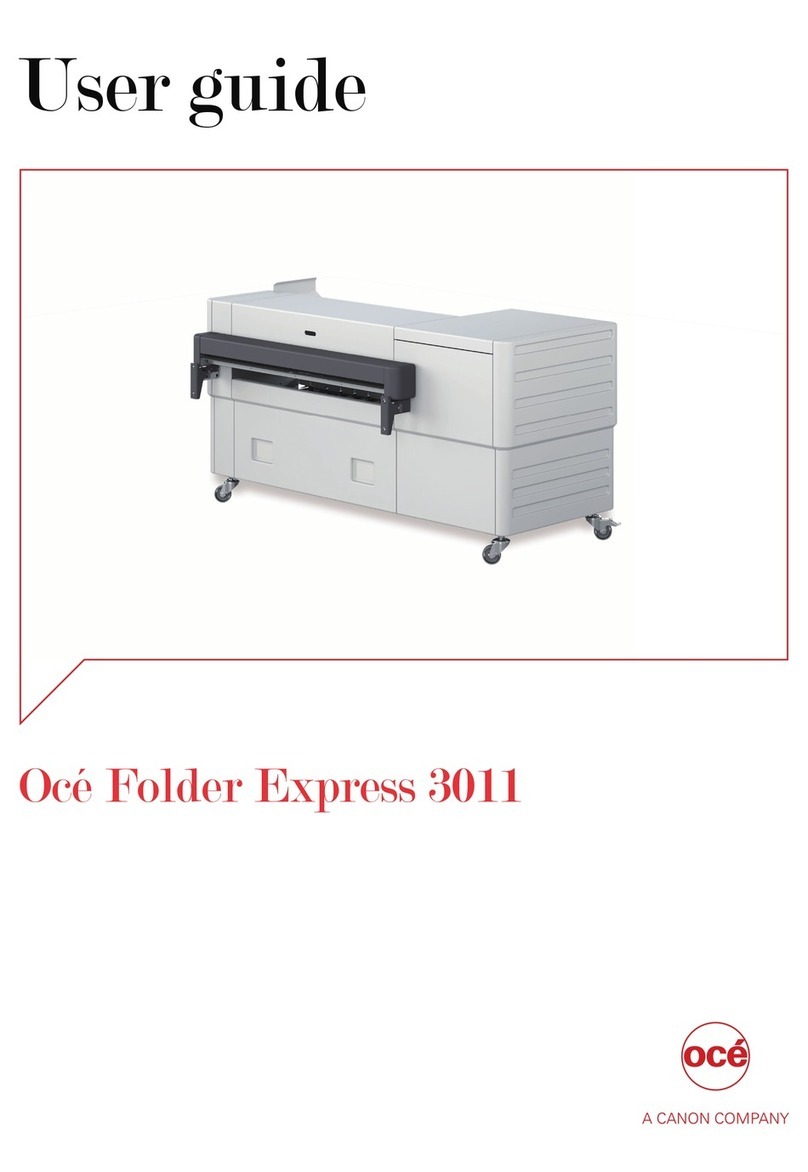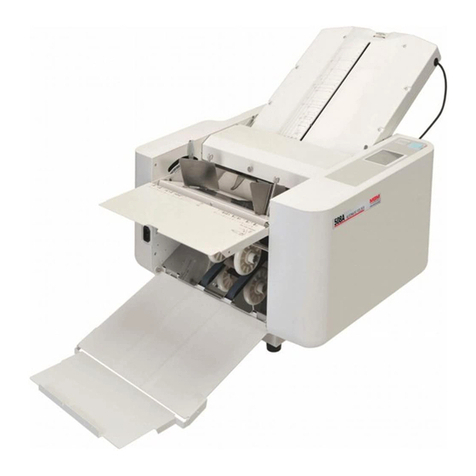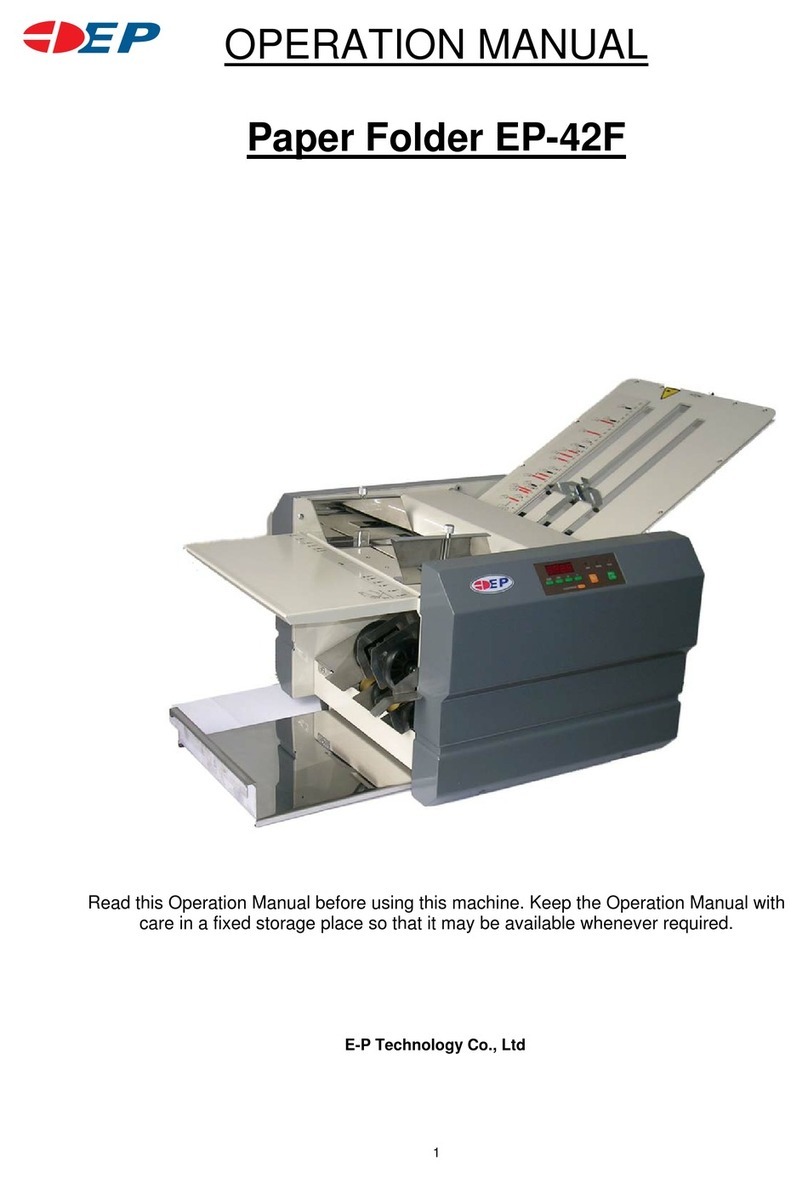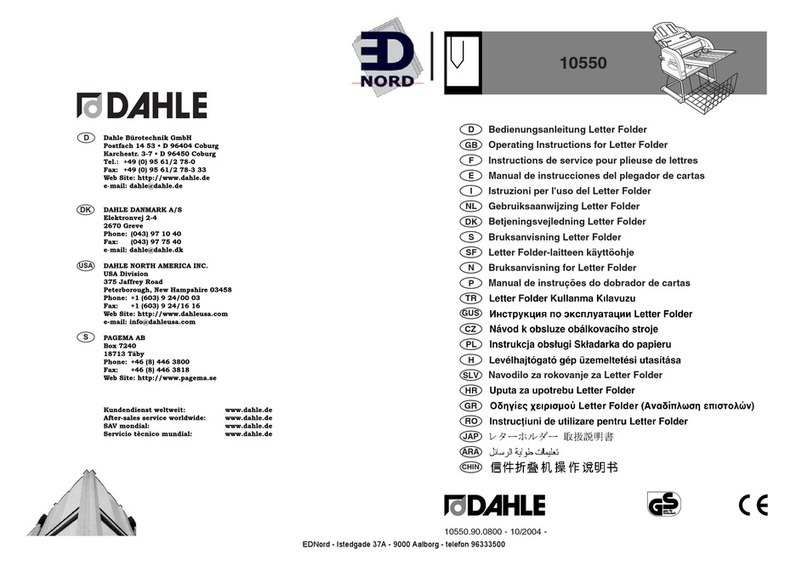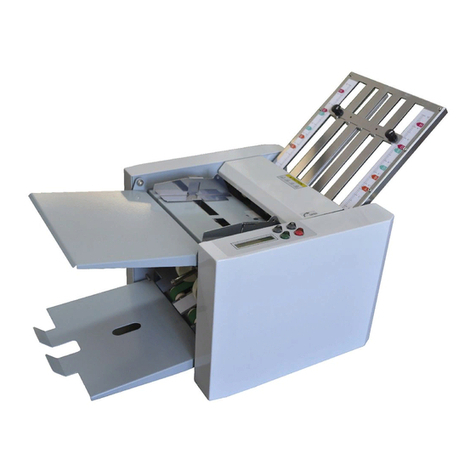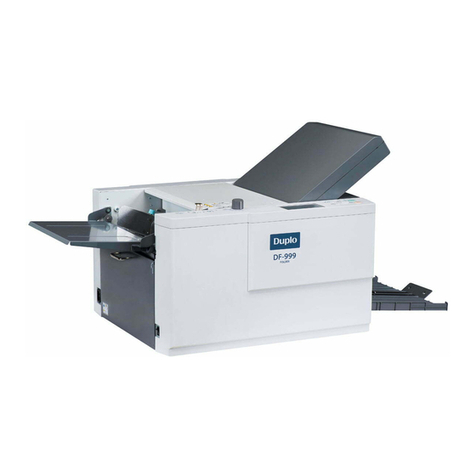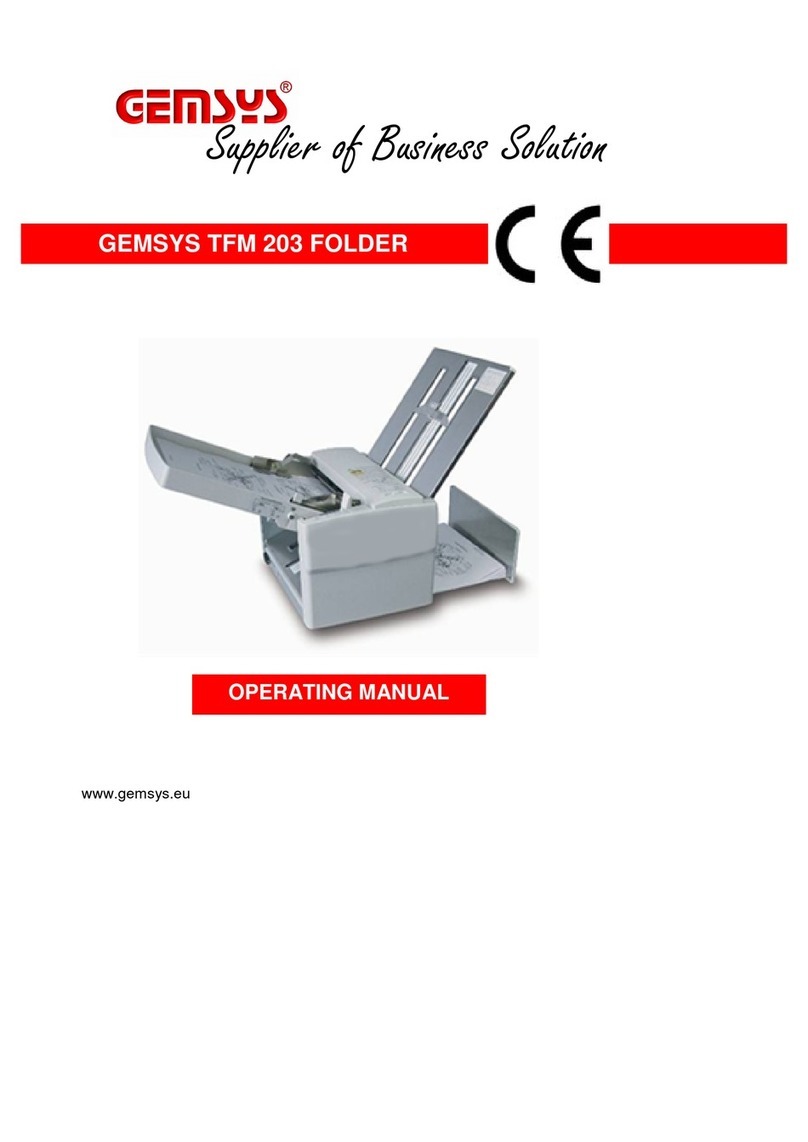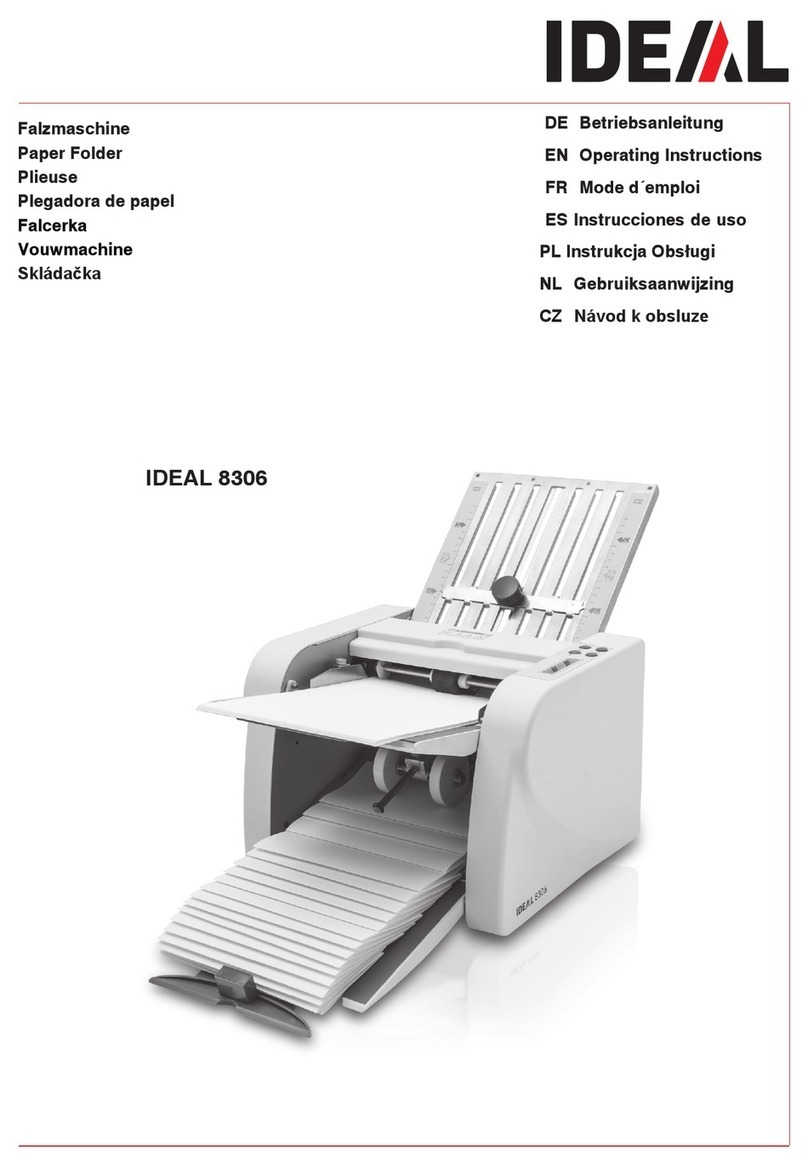Hefter TF MEGA-A User manual

Be sure to read this manual prior to use.
Please leave this manual at the site of use for easy reference.
TF MEGA-A
FOLDER
Instruction Manual

Introduction
Be sure to read this manual prior to using the product.
After reading, leave the manual at the site of use for easy reference whenever questions related to the
product arise in the future.
Symbols
In this manual, several symbols are used to indicate important warnings. Please make sure to read
instructions accompanied by these symbols. These symbols have the following
meanings.
Describes instructions which must be followed in use.
Be sure to read the instructions to avoid problems due to incorrect operations.
Indicates supplementary or useful information.
Describes names of related items and supplementary instructions.
Trademark
The product name and company name used in this manual are trademarks or registered trademarks of the
respective companies.

For EU
DECLARATION OF CONFORMITY
HEFTER Systemform GmbH, Am Mühlbach 6, 83209 Prien am Chiemsee, Germany, declares that the product (or products) complies with the
provisions dened in the regulations. The reference table is mentioned below.
Name of product Model
Regulation
Low Voltage Directive
2006/95/EC
under
Electromagnetic Compatibility
Directive
2004/108/EC under
Paper Folder TF MEGA-A IEC60950-1: 2005 + EN60950-1:
2006 + A11: 2009
EN61000-6-3: 2007
EN 55014-1: 2006
EN 55014-2: 1997 + A1: 2001 + A2:
2008
EN61000-3-2: 2006
EN61000-3-3: 2008
En
KONFORMITÄTSERKLÄRUNG
HEFTER Systemform GmbH, Am Mühlbach 6, 83209 Prien am Chiemsee, Deutschland, erklärt hiermit, dass das Produkt (oder die Produkte) die in den
Vorschriften denierten Bestimmungen erfüllt. Die Bezugstabelle ist unten aufgeführt.
Bezeichnung des
Produkts Modell
Richtlinie
Niederspannungsrichtlinie
2006/95/EG
unter
Richtlinie zur elektromagnetischen
Verträglichkeit 2004/108/EG unter
Papierfalzmaschine TF MEGA-A IEC60950-1: 2005 + EN60950-1:
2006 + A11: 2009
EN61000-6-3: 2007
EN 55014-1: 2006
EN 55014-2: 1997 + A1: 2001 + A2:
2008
EN61000-3-2: 2006
EN61000-3-3: 2008
Ge
DECLARATION DE CONFORMITE
HEFTER Systemform GmbH, Am Mühlbach 6, 83209 Prien am Chiemsee, Allemagne, déclare que le ou les produits sont conformes aux dispositions
dénies par la réglementation. Un tableau de référence est proposé ci-dessous.
Nom du produit Modèle
Réglementation
Directive Basse tension
2006/95/CE
en application de la
Directive sur la compatibilité
électromagnétique 2004/108/CE en
application de
Plieuse de papier TF MEGA-A IEC60950-1: 2005 + EN60950-1:
2006 + A11: 2009
EN61000-6-3: 2007
EN 55014-1: 2006
EN 55014-2: 1997 + A1: 2001 + A2:
2008
EN61000-3-2: 2006
EN61000-3-3: 2008
Fr
DICHIARAZIONE DI CONFORMITÁ
HEFTER Systemform GmbH, Am Mühlbach 6, 83209 Prien am Chiemsee, Germania, dichiara che il prodotto (o i prodotti) è/sono conforme/i ai requisiti
deniti dalle norme sottoelencate. La tabella di riferimento è riportata qui di seguito.
Nome del prodotto Modello
Direttiva Bassa Tensione
Direttiva 2006/95/CE relativa
alle apparecchiature a bassa
tensione
Direttiva di compatibilità
elettromagnetica 2004/108/CE in
base a
Macchina piegantesi di
carta
TF MEGA-A IEC60950-1: 2005 + EN60950-1:
2006 + A11: 2009
EN61000-6-3: 2007
EN 55014-1: 2006
EN 55014-2: 1997 + A1: 2001 + A2:
2008
EN61000-3-2: 2006
EN61000-3-3: 2008
It
DECLARACIÓN DE CONFORMIDAD
HEFTER Systemform GmbH, Am Mühlbach 6, 83209 Prien am Chiemsee, Alemania, declara que el producto (o los productos) cumple con las
disposiciones previstas en los reglamentos. Seguidamente se indica la tabla de referencia.
Nombre del producto Modelos
Reglamentación - Reglamentaciones
Directiva sobre baja tensión
2006/95/CE,
según
Directiva sobre compatibilidad
electromagnética 2004/108/CE,
según
Máquina que dobla de
papel
TF MEGA-A IEC60950-1: 2005 + EN60950-1:
2006 + A11: 2009
EN61000-6-3: 2007
EN 55014-1: 2006
EN 55014-2: 1997 + A1: 2001 + A2:
2008
EN61000-3-2: 2006
EN61000-3-3: 2008
Sp

For North America
Note:
This equipment has been tested and found to comply with the limits for a Class B digital device, pursuant to Part 15 of the FCC Rules. These limits are
designed to provide reasonable protection against harmful interference in a residential installation. This equipment generates, uses and can radiate
radio frequency energy and, if not installed and used in accordance with the instructions, may cause harmful interference to radio communications.
However, there is no guarantee that interference will not occur in a particular installation. If this equipment does cause harmful interference to radio
or television reception, which can be determined by turning the equipment o and on, the user is encouraged to try to correct the interference by
one or more of the following measures:
– Reorient or relocate the receiving antenna.
– Increase the separation between the equipment and receiver.
– Connect the equipment into an outlet on a circuit dierent from that to which the receiver is connected.
– Consult the dealer or an experienced radio/TV technician for help.

Disposal of Old Electrical & Electronic Equipment
is symbol (the symbol of the crossed out wheeled
bin) indicates that in European countries this product
should not be disposed of as household waste.
Please recycle where facilities exist by checking with
your local authority or supplier for recycling advice.
By ensuring this product is disposed of correctly
through proper treatment, recovery and recycling,
you will help prevent potential negative eects on the
environment and human health.
En
Entsorgung von alten elektrischen und
elektronischen Ausrüstungsteilen
Dieses Symbol (das Symbol mit dem durchgekreuzten
fahrbaren Müllbehälter) zeigt an, dass dieses Produkt
in europäischen Länden nicht als Haushaltsmüll
entsorgt werden darf. Bitte informieren Sie sich bei
Ihren örtlichen Behörden oder bei Ihrem Händler
hinsichtlich einer Empfehlung für die Entsorgung
und führen Sie die betreenden Teile dort, wo solche
Einrichtungen vorhanden sind, einem Recycling-
Prozess zu.
Indem sie sicherstellen, dass das betreende Produkt
durch richtige Behandlung, Rückführung und Recycling
entsorgtwird, tragen Sie dazu bei, möglichen negativen
Auswirkungen auf die Umwelt und die menschliche
Gesundheit vorzubeugen.
Ge
Elimination du matériel électronique et électrique
usagé
Ce symbole (une poubelle marquée d’une croix)
indique que dans les pays européens, ce produit ne
doit pas être éliminé comme des ordures ménagères.
Recyclez-le dans les sites adaptés qui vous seront
indiqués par les autorités locales ou renseignez-vous
auprès de votre fournisseur.
En veillant à ce que ce produit soit éliminé
correctement avec un traitement, une collecte et un
recyclage adaptés, vous contribuez à éviter son action
nocive potentielle sur l’ environnement et la santé
humaine.
Fr
Smaltimento di attrezzature elettriche ed
elettroniche consumate
Questo simbolo (il simbolo della pattumiera con rotelle
barrata) indica che nei paesi europei questo prodotto
non deve essere buttato nei rifiuti domestici.
Per favore smaltire in luogo addetto al riciclo, dove
esistente, chiedendo informazioni alle autorità locali o
a chi fornisce consulenza a proposito.
Garantendo uno smaltimento adeguato di questo
prodotto (trattamento, recupero e riciclo corretto),
aiuterete a prevenire eetti negativi sull’ambiente e
sulla salute dell’uomo.
It
Eliminación de residuos de aparatos eléctricos y
electrónicos
Este símbolo (un cubo de basura tachado) indica
que en los países europeos este producto no deberá
eliminarse como si se tratara de un residuo doméstico.
Solicite asesoramiento sobre reciclaje a las autoridades
locales o a su distribuidor, y siga la normativa en
materia de gestión medioambiental y reciclaje de este
tipo de residuos.
Si toma las medidas pertinentes para que este
producto se elimine mediante un tratamiento,
recuperación y reciclaje adecuados, contribuirá a evitar
posibles efectos negativos en el medio ambiente y la
salud humana.
Sp
For EU

i
Safety Precautions
Safety Precautions
In this manual, operations and handling of the unit which are hazardous are described using the following
marks to prevent personal injury or property damage to the user and others.
Ignoring this mark could result in the possibility of
serious injury or even death.
Ignoring this mark could result in the possibility of injury
or physical damage.
This mark indicates a“Warning”or “Caution”.
A graphic may be shown inside the mark to describe the warning or caution more specically.
This mark indicates a forbidden action.
A graphic may be shown inside the mark to describe the forbidden action more specically.
This mark indicates actions that must be performed.
A graphic may be shown inside the mark to describe the action to be performed more specically.
Power Supply
• This unit shall be installed near the socket-outlet where the plug on the power supply cord is easily
accessible.
• Make sure the power supply used is always within the following range.
Power supply : 220-240 V AC, 50 Hz (EU)
120 V AC, 60 Hz (North America)
• When you power other appliances from the same AC outlet, make sure that the combined power
consumption does not exceed the power supply capacity.
Rated current (Rated power) : 0.5 A (EU), 0.85 A (North America)
Use only the power supply voltage specied on the main nameplate.
Using other voltages could result in a re or an electrical shock.
Make sure that the combined power consumption of the appliances to be
connected does not exceed the capacity rating of the power outlets or plug
receptacles.
Exceeding the capacity rating could cause the power outlets, plug receptacles, or power extension cords to
overheat and catch a re.

ii
Safety Precautions
Operating Environment
Operate this unit in the following environment.
• where the temperature range is between 5 and 35°C/41 and 95°F (-10 to +50°C/14 to 122°F in storage)
• where the humidity range is between 20 and 80% RH (10 to 90% RH in storage, however no condensation)
• which is not subject to direct sunlight
• which is reasonably free from dust
• which is subject to little or no vibration
• which is free from air-borne salt
• where there are no harmful chemicals
• where the unit is not exposed to water
Keep this unit and the power cord away from heaters and heater vents.
Excessive heat could melt the cover or power cord covering, and result in a re or an electrical shock.
Do not place metal objects or vessels containing liquids on top of the unit.
The entry of any metal object or liquid could result in a re or an electrical shock.
Do not insert any metal or easily-combustible object inside this unit.
This could result in a re or an electrical shock.
Do not use ammable sprays inside or near the unit (e.g. when cleaning the
unit).
Such ammable gas may ignite and cause a re or combustion.
Do not install this unit in a location where there is excessive humidity or
where contact with water is possible.
Poor choice of location could result in deterioration of the insulation, a re or an electrical shock.
Install this unit on a level, stable stand or oor, with sucient space around it.
Failure to do so could result in the unit overturning and causing injury.
Disconnect the power plug from the power outlet before attempting to move
this unit.
Failure to do so could result in power cord damage, a re or an electrical shock.
Always disconnect the power plug from the power outlet when the unit is not
to be used for an extended period.
Failure to do so could result in a re due to leakage current if the insulation should deteriorate.

iii
Safety Precautions
Maintenance / Other
Do not damage the power cord or power plug.
Do not scratch, alter, bend, twist, pull or place heavy objects on the power cord or power plug.
This could result in damage, a re or an electrical shock.
Do not touch the power switch with wet hands.
Otherwise electric hazards may occur.
Do not remove the cover or back panel.
This unit contains high-voltage components that could cause an electrical shock.
Do not disassemble, modify or repair this unit.
There is a danger of re, electrical shock or injury.
Contact your dealer when repairs are necessary.
If any foreign object such as metal or liquid should enter this unit,
immediately turn the unit o at the power switch and disconnect the power
plug from the power outlet.
Failure to do so could result in a re or an electrical shock.
Contact your dealer immediately.
Before cleaning this unit, turn the unit o at the power switch and disconnect
the power plug from the power outlet.
Accidental operation of the unit during cleaning could result in injury.
Remove any dust that accumulates on the power plug prongs and the surface
of the plug from which the prongs extend.
Accumulated dust could result in a re.
Always grip the plug when disconnecting the power plug from the power
outlet.
Forcibly pulling on the power cord could cause damage, resulting in a re or an electrical shock.
Do not touch or insert foreign objects into any rotating part during operation.
This could result in injury.

iv
Safety Precautions
WARNING / CAUTION Labels
"WARNING" and "CAUTION" labels are pasted on the machine to ensure user safety.
Do not remove or change them.
When the labels become dirty or are lost, be sure to contact your dealer for a new one.
When changing a fuse, make
sure that the fuse rating is same
as that indicated on this label.
North America
EU
H
H

v
Contents
Contents
Safety Precautions .............................................i
Power Supply.................................................................................i
Operating Environment ...........................................................ii
Maintenance / Other ............................................................... iii
WARNING / CAUTION Labels................................................ iv
Chapter1Before Operation
1. Features................................................... 1-1
2. Setting Up the Machine ......................... 1-2
2-1. Components.............................................................. 1-2
2-2. Removing the Press Release Lever................... 1-3
2-3. Locking the Bearing Support Levers ............... 1-4
2-4. Attaching the Parts ................................................. 1-5
3. Names and Functions............................. 1-8
4. Describing Control Panel..................... 1-10
5. Screen Menus........................................1-11
6. Handling Paper.....................................1-12
6-1. Paper Used ...............................................................1-12
6-2. Precautions on Stacking Paper ........................1-12
7. Emergency Stop....................................1-14
Chapter2Basic Operation
1. Standard Folding of Standard Paper.... 2-1
1-1. Standard Paper......................................................... 2-1
1-2. Standard Folding ..................................................... 2-2
1-3. Operation Procedures ........................................... 2-2
Chapter3Advanced Operation
1. Standard Folding of Special Paper ....... 3-1
1-1. Single Folding Thick Paper................................... 3-1
1-2. Double Folding Thick Paper................................ 3-2
1-3.
Double Folding B6 Thin Paper (EU)/Small
Thin Paper (North America)............................................3-4
2. Custom Folding of Standard Paper ...... 3-7
3.
Standard Folding of Non-Standard Size
Paper..............................................................3-11
4. Cross Folding ........................................3-13
4-1. Cross Folding Standard Size Paper.................3-14
4-2. Cross Folding Non-Standard Size Paper.......3-17
5. Using Art Paper and Coated Paper..... 3-19
5-1. Characteristics of Art Paper and Coated
Paper...........................................................................3-19
5-2. Operation Procedures .........................................3-19
6. Correcting Folding Misalignment.......3-20
6-1. Correcting Folding Misalignment along
Vertical Length of Paper .....................................3-20
6-2. Correcting Folding Misalignment along
Sides of Paper..........................................................3-23
Chapter4
Troubleshooting Guide
1. Correcting Deformed Folding ....................... 4-1
2. Removing Jammed Paper...................... 4-1
2-1. When Paper Has Jammed Near the Paper
Feed Ring .................................................................... 4-1
2-2. When Paper Has Slipped at the Paper
Feed Section.............................................................. 4-2
2-3. When Paper Has Coiled Around the Rubber
Roll................................................................................. 4-3
2-4. When Paper Has Jammed at the First
Folding Plate.............................................................. 4-4
2-5. When Paper Has Jammed at the Second
Folding Plate.............................................................. 4-5
2-6. When Paper Has Jammed Near the
Stacker.......................................................................... 4-7
3. Error Messages ....................................... 4-8
4. Troubleshooting..................................... 4-9
Chapter5Cleaning the Unit
1. Cleaning Each Section............................ 5-1
1-1. Cleaning the Rubber Roll ..................................... 5-1
1-2. Cleaning the Paper Feed Rings.......................... 5-2
1-3. Cleaning the Paper Separator ............................ 5-3
1-4. Cleaning the Paper Sensor .................................. 5-4
1-5. Cleaning the Ejection Gate Sensor................... 5-4
1-6. Cleaning the Paper Ejection Belts..................... 5-4
Chapter6Appendix
Specication.................................................. 6-1

1-1
Chapter1 Before Operation
Chapter1 BeforeOperation
1. Features
The TF MEGA-A is designed to fold paper into six popular folding modes and is capable of folding the
following number of sheets:
For EU
Approximately 125 sheets of paper per minute when single folding A4 size ne quality paper 64 g/m2
For North America
Approximately 135 sheets of paper per minute when single folding 11 lb of ne quality LT paper
Single fold Double fold Irregular accordion fold Letter fold Accordion fold Gate fold
The TF MEGA-A is also able to create cross single fold and cross letter fold as shown in the gure.
Cross fold Cross single fold
Cross letter fold
Note that the nish of cross folding is not as accurate as that of the six folding modes mentioned
above.
(Fold out) (Z fold)

1-2
Chapter1 Before Operation
2. Setting Up the Machine
2-1. Components
[1] [2] [3]
[4] [5] [6]
[7]
220 to 240 V (For EU)120 V (For North America)
No. Name Qty. Remark
[1] First folding plate 1 Attached to the right upper section on the operator's side.
[2] Second folding plate 1 Attached to the right lower section on the operator's side.
[3] Instruction manual 1 This manual
[4] Scale label 1 Used to measure non-standard size paper. Attach the scale.
[5] Guide plate unit 1 Used when folding B6 size thin paper into four. (EU)
Used when folding small sized medium thickness paper into four.
(North America)
[6] Cross folding lever 1 Used when cross folding paper.
[7] Power cord 1

1-3
Chapter1 Before Operation
2-2. Removing the Press Release Lever
The press release levers are attached to the unit at shipment to prevent the rubber roll from becoming
distorted. Be sure to remove them when setting up the machine.
The two types of press levers are attached to either side of the rubber roll.
Press release lever (A)
Operator’s side
Rubber roll
Press release lever (B)
Press release lever (A)
Press release lever (B)
Non-operator’s side
Rubber roll
The machine will be damaged if it is used without removing the lever.
1 To remove the press release lever (A) on the non-operator’s side, push it inwards and
pull it out.
Press release lever (A) Press release lever (A)
2 To remove the press release lever (A) on the operator’s side, push it inwards and pull it
out.
3 To remove the press release lever (B) on the non-operator’s side, push it inwards and
pull it out.
Press release lever (B) Press release lever (B)
4 To remove the press release lever (B) on the operator’s side, push it inwards and pull it
out.

1-4
Chapter1 Before Operation
2-3. Locking the Bearing Support Levers
The bearing support levers are released at shipment to prevent the rubber roll from becoming distorted.
After removing the press release levers, be sure to lock the bearing.
Support paper feed plate
Paper receiving
stopper
Paper receiving
tray
1 Unfold the paper receiving tray.
2 Unfold the support paper feed plate.
• If you unfold the support paper feed
plate before unfolding the paper
receiving tray, the paper receiving
stopper may be damaged. Make sure
that you unfold the paper receiving tray
rst.
• The paper receiving tray and support
paper feed plate are foldable so that you
can easily move or store the machine.
Make sure that you unfold them before
using the machine.
Top cover
3 Open the top cover.
Bearing support lever
Operator’s side
4 Turn the bearing support lever on the
operator’s side in the direction of the
arrow.
The bearing will be locked.

1-5
Chapter1 Before Operation
Bearing support lever
Non-operator’s side
5 Turn the bearing support lever on the
non-operator’s side in the direction of
the arrow.
The bearing will be locked.
Because the bearing support lever presses
down the rubber roll, if it is not locked,
thick paper may not be folded properly.
6 Close the top cover.
2-4. Attaching the Parts
1 Attach the second folding plate.
Second folding plate
Lock lever
UNLOCK
LOCK
1) Move the lock lever of the second folding
plate to the position of“UNLOCK.”
2) Slide the second folding plate to the
machine along the shaft on each side of the
frame, then insert the U-shaped gutter on
the edge of each side into the shaft located
on the back of the frame.
3) Move the lock lever to the position of
“LOCK.”

1-6
Chapter1 Before Operation
First folding plate
UNLOCK
LOCK
Lock lever
2 Attach the rst folding plate.
1) Move the lock lever of the rst folding plate
to the position of “UNLOCK.”
2) Slide the rst folding plate to the machine
along the shaft on each side of the frame,
then insert the U-shaped gutter on the
edge of each side into the shaft located on
the back of the frame.
3) Move the lock lever to the position of
“LOCK.”
Connector 1
Control cable 1
Control cable 2
1
2
2
1
Connector 2
3 After attaching the folding plates,
connect the control cable of the rst
folding plate to the connector "1" and
that of the second folding plate to the
connector "2."
• Be careful not to connect the control
cable to a wrong connector.
• Be sure to turn o the power before
connecting or disconnecting the
control cable. Otherwise the unit will
malfunction.
Guide plate unit
4 Place the guide plate unit on the
magnet under the top cover.
Cross folding lever
5 Insert the cross folding lever to the
shaft located on the operator's side
under the top cover.

1-7
Chapter1 Before Operation
Memo

1-8
Chapter1 Before Operation
3. Names and Functions
[1]
[2]
[3]
[4]
[5]
[6]
[7]
[8]
[9]
[10]
[11]
[13]
[14]
[15]
[16] [17]
[18]
[12]
Under the main cover
Paper feed tray (operator’s side)

1-9
Chapter1 Before Operation
No. Name Function
[1] First folding plate Guide plate for deciding a paper folding position. First folding is
made using this plate.
[2] Control panel Used when operating the machine. Error messages are also
displayed on the LCD display.
[3] Second folding plate Paper folded at the rst folding plate is sent to the second folding
plate. Second folding is made using this plate. This plate is not
used when folding paper into two.
[4] Power switch Turns on and o the power.
[5] Paper receiving tray Receives folded paper ejected out.
[6] Paper receiving stopper Stops paper ejected out from the machine.
[7] Stacker rollers Ejects folded paper from the machine.
[8] Paper set lever When lowered, the paper feed tray is raised.
[9] Support paper feed plate Supports paper stacked on the paper feed tray.
[10] Paper feed tray Used to stack paper to be folded.
[11] Side guide Holds paper stacked on the paper feed tray.
[12] Top cover Prevents the user from touching the moving parts.
[13] Jam correction knob Removes paper jammed around the rubber roll by turning the
knob.
[14] Paper feed ring Feeds paper into the machine.
[15] Rubber roll Sends paper to the rst folding plate.
[16] Separating pressure adjustment dial Adjusts the paper separating pressure.
[17] Paper feed pressure adjustment knob Adjusts paper feed pressure.
[18] Slant correction paper feed knob Corrects misalignment along sides of paper.

1-10
Chapter1 Before Operation
4. Describing Control Panel
[1]
[2][3][4][5][6][7][8][9][10]
[12][13][14][15]
[11]
No. Name Function
[1] Counter/LCD display A paper size, folding mode, the number of folded paper or error
messages are displayed.
[2] key When pressed, the machine stops.
[3] key When pressed, the machine starts folding operations.
[4] C (clear) key • When the machine is stopped with paper on the paper feed tray,
pressing this key for more than two seconds makes the counted
number return to "0."
• When a mis-feed has occurred, pressing this key clears the
message.
• When set to subtract count, pressing this key cancels the subtract
count mode and returns to the add count mode.
[5] (test) key Starts test folding.
[6] key, key Sets the details for non-standard size paper, custom folding or
folding position correction, species the number for subtract
count, or changes the stacker rollers position.
[7] (count) key Switches the count mode from add count to subtract count.
[8] (stacker roller position correction)
key
Corrects the automatically set position of the stacker rollers.
[9] (second folding stopper
adjustment) key
Adjusts the automatically set folding position or species the size
of custom folding.
[10] (rst folding stopper adjustment)
key
Adjusts the automatically set folding position or species the size
of custom folding.
[11] (paper length setting) key Species the paper length when folding non-standard size paper
in a standard folding mode.
[12] Folding mode, paper feed/eject
direction lable
Shows the paper feed direction and front/back of paper and how
folded paper is discharged from the machine. Use this label when
selecting a folding mode using the folding mode key.
[13] (folding mode) key Selects a folding mode (six patterns).
[14] (paper size) key Selects a paper size from A3, B4, A4, B5, A5, B6, LP (non-standard
size) and CF (paper for custom folding). (EU)
Selects a paper size from LD, LG, LT, ST/IN, LP (non-standard size)
and CF (paper for custom folding). (North America)
[15] Paper feed pressure label Refer to this label when setting paper feed pressure according to
the paper quality.
Table of contents
Other Hefter Folding Machine manuals
